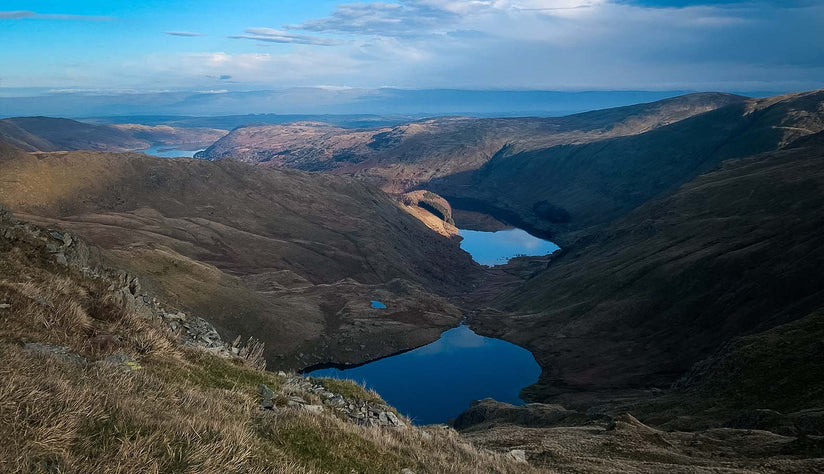Not for the fainthearted, an ultra-run is for experienced runners looking to take their running to the next level. Typically the next step up from a marathon, ultra running may seem a daunting prospect to undertake, but with the right training and mindset, taking on an ultra is more achievable than you might first think.
#TeamMontane’s Marie Cheng is a passionate runner who only got into long-distance running in recent years. Keep reading to discover her advice for others keen to get involved, including popular ultra trail runs to try, essential preparation and her top tips...
Marie’s ultra running journey
In 2024, I will be racing the MIUT 42K race in Madeira in April and the Montane Lakeland 50 Miler in the Lake District in July. My journey to being a trail and mountain runner could be described as somewhat of a baptism of fire! Before moving to Sheffield, I spent a lot of my early working life in London, and I’ll be honest in saying that the extent of my running was the occasional circuit of the local Park Run. I very much viewed running as a means to an end – a way to keep fit and ticking over the legs as prep for longer hill walks or skiing during the winter.
It was not until post-lockdown in May 2021, that the concept of trying out running in the hills was introduced to me at a trail running workshop. Living in the Peak District, I would often see trail runners with their small packs and lightweight clothing tearing it down the hills! So officially in September 2021, I made a conscious decision to “take running more seriously” and started getting coached by a fellow member of Team Montane, athlete Howard Dracup.
It’s true what they say, that once you start running, it can well and truly suck you in! Since 2021, running has seemingly taken over my life in a training capacity, but also from a work perspective, as I now work freelance for many UK races.
Under the watchful and carefully managed structured training plans of my coach Howard, I have been able to complete two ultras to date – Ultra Trail Snowdonia 55K in 2022 and OCC, the 55K race part of the UTMB finals, in 2023.

And whilst jumping straight in at the deep end probably isn’t the ideal recommended way of getting into ultrarunning, I would say don’t let big goals deter you from trying. With the right type of support and attitude, we can all achieve much more than we think and if I can do it, so can you.
What is an ultra-marathon
We have seen a huge increase in the popularity of ultramarathons over the last few decades, with figures suggesting that there has been a 1676% increase in participation of ultrarunning events globally since 1996 and 2020.
So what is an “ultra”? An ultra or an ultramarathon is a running event or challenge that exceeds a marathon distance (42km/26.2 miles) and can come in many shapes and forms. They can be on-road or off-road (trails/mountains/desert), or sometimes even a mixture of both; some ultras can be completed in a day, others might be completed over multiple days.
For most people moving into the ultramarathon distances, the 50K distance is usually the next step up from a marathon, and often the most common and popular distance, especially if you are just starting out.
I think whilst there has been a big trend towards ultras, I’m cognisant of highlighting the fact that jumping on the ultra-train isn’t a required rite of passage to make you a “real runner”! Running an ultra-distance isn’t something we all have to do, nor necessarily even want to and there is such a big choice of races out there now that caters for so many different distances.
What I will say though is that an exciting part of YOUR OWN running journey - and something that I haven’t even worked out for myself yet - is the process of finding out what type of race (distance/terrain/location) rocks your boat! This year I tried out my first few short (muddy!) fell races and loved them!
For those who are keen to explore the ultramarathon route however, the race list is now so extensive, to pick just a few is difficult! However here are a few that you might have come across or seen on the big screen:
- UTMB (Ultra-Trail du Mont Blanc)
- Tor de Geants
- The Spine Race
- Dragon’s Back Race
- MIUT (Madeira Island Ultra Trail)
- Hardrock 100
- Barkley Marathons
- Marathon de Sables
- Western States 100
- Lakeland 50 and 100
- Race to the Stones

Essential Preparation
Any good coach will talk about the fact that training for a race, of any length, let alone an ultra, requires consistency and an investment of your time and effort.
Ultras tend to incur additional stress on your body, given the longer distances, as well as varied terrain and elevation factors. This makes it even more important when you’re choosing to do an ultra, that you give yourself sufficient time to train your body so that it is ready for your race.
There are many ways to tackle training, but for those fairly new like me to the ultrarunning world, here’s my slightly more simplistic take on the various components of a training plan for an ultra:
-
Running and Overall Run Volume – To run a long distance, unsurprisingly you to need to run quite a lot in your training! A training plan will usually build up your overall run volume over time. It is also important to note that 80% of your runs will be at an easy recovery run pace to allow you to build up volume safely and prevent injuries. For someone pretty much new like me, I started with a lot of 30-minute runs in the week, which progressed to 45-minute runs and then onto 1-hour runs. After a while, longer runs will also be introduced on the weekends.
-
Strength and Conditioning (S&C) Training – For a lot of new runners like me, we tend to start running and then only run! That is until…you get a niggle or injury. Coaches and physios will always advocate having S&C sessions within your training plan where you work on building your muscle and joint strength. This will not only let you become a stronger runner but also help to prevent injuries.
-
Cross Training – Your training plan might also incorporate other exercise sessions such as cross-training. I think cross-training is underrated and I love having a spin class option in my week! Yes many of us tend to revert to cross-training when we are injured, but cross-training also provides some variety, can be used to improve fitness, and is a good way to actively recover.
There are a lot of additional areas aside from the physical training, which will likely be added as considerations as you progress in your ultra-training including Nutrition and Hydration, Kit Testing, and Recces.

Nutrition
The length and type of ultra you will be doing will play a big factor in determining your race and training nutrition strategy. Something that I have learned and also observed in my relatively short time running, is that a common pitfall from people starting out or also those coming over from road running to running trails (and then mountains) is the underestimation in the time that they expect to be out running.
Elevation (the amount of uphill and also just as importantly the amount of downhill) as well as the type of terrain underfoot will play a big part in approximating the length of time you will be out on your race/training. And with that, it means that you will need to think more carefully about your nutrition and hydration strategy to make sure that you will have sufficient fuel to be out for that length of time.
There is a lot of literature and also qualified sports dietitians out there who are well placed to talk about nutrition strategy for races, including gut training. As you progress on your training, I would recommend exploring working with someone qualified in this area, for example, #TeamMontane’s Renee McGregor.
Choosing the right ultra
So now you’ve decided you want to do an ultra, what’s the best way to go about choosing the right one?
First of all, there is no “right ultra” just the right ultra for you. That said, if you are just starting, there are some great articles out there that highlight some of the beginner-friendly” races so definitely have a look at these for some inspiration!
The main things to consider in my view are:
-
Is the race supported? Is it course-marked so you don’t have to self-navigate? Are there checkpoints and aid stations on route so that you can top up your food and drink supplies? Are there safety teams on hand in case something goes wrong?
-
How far apart are the checkpoints/aid stations? Going into an ultra for the first time, it’s probably good to have a race where the aid stations are quite close together for both food/drink top-ups but also more frequent touch points on the race.
- How generous are the cut-off times?
-
The elevation gain/loss of the route and technicality of the race – You might like to start with a less hilly and less technical race as your first one
-
Are there any feeder races? Are there any ultras that have “feeder”/smaller distances that cover some of the type of route or even the route itself of your ultra that you can use in training?
Aside from the points listed, I would say that the main overriding factor in my view is – choose a race that excites you!

Choosing a race that interests you and that you care about will play a big part in motivating you to race and more importantly train! If you know your why for running and racing, it will be far less painful on those cold, dark and wet days to get up and train!
Top Tips
-
BE PATIENT
I think one of the biggest things that I have learned is the need to be patient with yourself. And two and a half years on, I probably still haven’t cracked it yet either! It is really easy when you are starting to get caught up and carried away - wanting to book every race under the sun (luckily I had a coach to stop me and stop me being perpetually injured!) and attend every single running event! But I would say pace yourself.
It is also important to remember that your training progress is never linear and to stop comparing yourself to what everyone else is doing. When I first started running I would often find myself getting very frustrated when I was having bad days or when perhaps I was realising that I couldn’t run as fast, as far or as high as everyone else. As someone who has been running only for 2-3 years, you are still very much a “beginner” in your running life and your body takes time to adapt.
-
FAIL TO PREPARE, PREPARE TO FAIL
As someone who is not the fastest runner on a race, it means that the other factors that determine whether you are going to finish the race suddenly become incredibly important and relevant. A big part of why I like to run, train and race is that I really enjoy the strategy, planning, and organisation that goes with it (probably why I also really like crewing and working on races!). In the weeks and months leading up to a race I usually do a few things:
Research the race – This includes knowing the event schedule, to the cut-off times, and the cut-off pace I need to maintain/be over, to the location and distances of all the checkpoints, to knowing what will be at the checkpoints to the route profiles.
Recce the race route – Where you can, recceing the route is incredibly helpful as part of your specificity training but also gives you a lot of confidence and peace of mind for race day. It’s not always possible to recce routes, but if you can best simulate or familiarise yourself with the conditions e.g. using stair climbers or equally I watch a lot of old YouTube videos to get an idea of the terrain and race route.
Plan my nutrition – In planning, I also work out the distance between checkpoints and roughly estimate how long this might take me. I then “bag up” all the run nutrition/food I know that I should be eating for that stage. By planning, essentially you are taking away the element of needing to think on the race when you’re tired. And by bagging up your food, you will know then straight away at a checkpoint if you’ve been eating enough.
-
TRAIN YOU BRAIN AS MUCH AS YOUR LEGS
Doing the training is not just preparing your body physically to take on the challenge but training your brain to be mentally resilient. If you live in the UK, I can guarantee there will be days in your training where you won’t want to go out, or mid-run when you are soaked, tired, and want to go home. It is only by putting yourself in the testing conditions that you subconsciously become more resilient. Remember we are all far more capable of what we give ourselves credit for and we are often our own worst enemies. Train your brain when you’re out and when you want to stop - tell yourself you CAN do this!
-
TREAT YOUR RUNNING AS A JOURNEY
Embrace the highs and lows and make the most of all days, even the bad ones. If all training and races were perfect, none of us would ever improve. Most of all if you can get yourself to enjoy the training process, I’d say you’re probably on the way to cracking it!

This blog was written by #TeamMontane member Marie Cheng. Feeling inspired? Discover technical, lightweight running gear built for the world's toughest trails to get started on your ultra-running journey today.
















